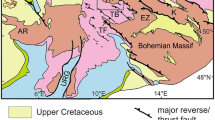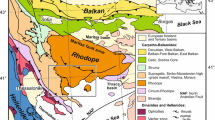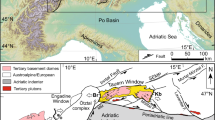Abstract
Vertical displacements on the SW–NE Têt fault (Eastern Pyrenees Axial Zone, France), which separates the Variscan Canigou-Carança and Mont-Louis massifs, were constrained using a thermochronologic multi-method approach. 40Ar/39Ar data from the granitic Mont-Louis massif record its Variscan cooling history and reveal no ages younger than Early Cretaceous, while the Canigou-Carança gneiss massif records systematically younger 40Ar/39Ar ages. These younger 40Ar/39Ar ages in the Canigou-Carança gneiss massif are the result of partial to total rejuvenation of argon isotopic systems related to a thermal flow coeval with the Cretaceous HT-BP metamorphism in the North Pyrenean Zone. Only the deepest rocks from the Canigou-Carança suffered this extensive Mid-Cretaceous thermal overprint probably due to differential burial around 4 km at that time. The post Mid-Cretaceous vertical displacements along the Têt fault are recorded by “low” temperature thermochronology using K-feldspar 40Ar/39Ar, zircon and apatite fission track and (U–Th)/He datings. The Mont-Louis granite samples experienced a long period of protracted cooling reflecting a lack of thermo-tectonic activity in this area from Late Palaeozoic to Early Cenozoic, followed by cooling from 55–60 Ma to Late Eocene at a mean rate of 15–20°C/Ma in the final stage. This cooling stage corresponds to Têt fault reactivation with a reversed component, promoting exhumation of the Mont-Louis roof zone contemporaneously with the south-vergent Pyrenean thrusting. In the Canigou-Carança massif, the main cooling event occurred from 32 to 18 Ma at a maximum rate of 30°C/Ma during Early Oligocene followed by a more moderate rate of 3°C/Ma from Late Oligocene to Early Burdigalian, coeval with the normal reactivation of the Têt fault in brittle conditions that accommodated the final exhumation of the massif during the opening of the Gulf of Lion.









Similar content being viewed by others
References
Albarède F, Ferraud G, Kaneoka I, Allègre CJ (1978) 39Ar/40Ar dating: the importance of K-feldspars on multi-mineral data of polyorogenic areas. J Geol 86:581–598
Arnaud NO, Tapponnier P, Roger F, Brunel M, Schärer U, Wen C, Xu Z (2003) Evidence for Mesozoic shear along the western Kunlun and Altyn-Tagh fault, northern Tibet (China). J Geophy Res Solid Earth 108(B1), Art no. 2053. doi:10.1029/2001JB000904
Autran A, Fonteilles M, Guitard G (1970) Relations entre les intrusions de granitoïdes, l’anatexie et le métamorphisme régional, considérées principalement du point de vue du rôle de l’eau: cas de la chaîne hercynienne des Pyrénées orientales. Bull Soc Géol Fr 7:673–731
Azambre B, Rossy M (1976) Le magmatisme alcalin d’âge crétacé dans les Pyrénées occidentales et l’arc basque: ses relations avec le métamorphisme et la tectonique. Bull Soc Géol Fr 6:1725–1728
Barbey P, Cheilletz A, Laumonier B (2001) The Canigou orthogneisses, Eastern Pyrenees, France, Spain): an Early Ordovician rapakivi granite laccolith and its contact aureole. CR Acad Sci 332:129–136
Braun J (2002) Quantifying the effect of recent relief change on age–elevation relationships. Earth Planet Sci Lett 200:331–343
Briais A, Armijo R, Winter T, Tapponier P, Herbecq A (1990) Morphological evidence for Quaternary normal faulting and seismic hazard in the Eastern Pyrenees. Ann Tectonicæ 4:19–42
Burrus J (1984) Contribution to a geodynamic synthesis of the provencal basin (north-western mediterranean). Marine Geol 55:247–269
Burbank DW, Puigdefábregas C, Muñoz JA (1992) The chronology of the Eocene tectonic and stratigraphic development of the eastern Pyrenean foreland basin (Northeast Spain). GSA Bull 16:63–83
Calvet M (1996) Morphogenèse d’une montagne méditerranéenne, les Pyrénées orientales. Thèse doct., Université Paris I et documents du BRGM 255, pp 1–1170
Carignan J, Hild P, Mevelle G, Morel J, Yeghicheyan D (2001) Routine analyses of trace element in geological exemples using flow injection and low pressure on-line liquid chromatography coupled to ICP-MS: a study of geochemical reference materials BR, DR-N, UB-N, AN-G and GH. Geos Newsl 25:187–198
Choukroune P (1992) Tectonic evolution of the Pyrenees. Annu Rev Earth Planet Sci Lett 20:143–158
Choukroune P, Mattauer M (1978) Tectonique des plaques et Pyrénées: sur le fonctionnement de la faille transformante nord-pyrénéenne: comparaison avec les modèles actuels. Bull Soc Géol Fr 5:689–700
Choukroune P, Team ECORS (1989) The ECORS Pyrenean deep seismic profile reflection data and the overall structure of an orogenic belt. Tectonics 8:23–39
Clauzon G, Fauquette S, Suc JP (2002) Quantification des paléoaltitudes néogènes des reliefs des Pyrénées orientales. Colloque du GdR Marges, pp 40–41
Dahl PS (1996) The crystal-chemical basis for argon retention in micas: inferences form interlayer partitioning and implications for geochronology. Contrib Mineral Petrol 123:22–39
Debon F, Enrique P, Autran A (1996) Le plutonisme hercynien des Pyrénées. In: Barnolas A, Chiron JC (eds) Synthèse géologique et géophysique des Pyrénées, vol I. Edition BRGM-ITGE, pp 361–499
Delaperrière E, Soliva J (1992) Détermination d’un âge Ordovicien supérieur - Silurien pour les gneiss de Casemi, massif du Canigou, Pyrénées Orientales) par la méthode d’évaporation du plomb sur monozircon. CR Acad Sci 314:345–350
Delcaillau B, Carozza J-M, Font M (2004) Le segment nord de la faille de la Tet (Pyrènées-Orientales): fonctionnement néogène et implications géomorphologiques. Bull Soc Géol Fr 175:257–272
Deloule E, Alexandrov P, Cheilletz A, Laumonier B, Barbey P (2002) In-situ U–Pb zircon ages for early Ordovician magmatism in the eastern Pyrenees, France: the Canigou orthogneisses. Int J Earth Sci 91:398–405
Déramond J, Souquet P, Fondecave-Wallez MJ, Specht M (1993) Relationships between thrust tectonics and sequence stratigraphy surfaces in foredeeps: model and examples from the Pyrenees (Cretaceous-Eocene, France, Spain). In: Williams GD, Dobb A (eds) Tectonics and seismic sequence stratigraphy. Spec Publ Geol Soc, London, pp 193–219
Dodson MH (1973) Closure temperatures in cooling geological and petrological systems. Contrib Mineral Petrol 40:259–274
Fabriès J, Lorand JP, Bodinier JL (1998) Petrogenetic evolution of orogenic lherzolite massifs in the central and western Pyrenees. Tectonophysics 292:145–167
Farley KA (2002) (U–Th)/He dating: techniques, calibrations, and applications. In: Porcelli PD, Ballentine CJ, Wieler R (eds) Noble gas geochemistry. Rev Mineral Geochem 47:819–843
Farley KA (2003) Problematic samples for apatite (U–Th)/He dating: some possible causes and solutions. AGU Fall Meeting, San Fransisco
Farley KA, Wolf RA, Silver LT (1996) The effects of long alpha-stopping distances on, (U–Th)/He ages. Geochim Cosmochim Acta 60:4223–4229
Fitzgerald P, Muñoz JA, Coney P, Baldwin SL (1999) Asymetric exhumation across the central Pyrenees: implications for the tectonic evolution of a collisional orogen. Earth Planet Sci Lett 173:157–170
Galbraith RF (1981) On statistical models for fission track counts. J Int Assoc Math Geol 13:471–488
Gallagher K (1995) Evolving temperature histories from apatite fission-track data. Earth Planet Sci Lett 136:421–435
Gibson RL (1989) The relionship between deformation and metamorphism in the Canigou massif, Pyrenees: a case study. Geol Mijnb 68:345–356
Golberg JM, Leyreloup AF (1990) High temperature–low pressure Cretaceous metamorphism related to crustal thinning (Eastern North Pyrenean Zone, France). Contrib Mineral Petrol 104:194–207
Golberg JM, Maluski H (1988) Données nouvelles et mise au point sur l’âge du métamorphisme pyrénéen. CR Acad Sci 306:429–435
Green PF, Duddy IR, Gleadow AJW, Laslett GM, Tingate PR (1986) Thermal annealing of fission tracks in apatite, 1. A qualitative description. Chem Geol 59:234–253
Guitard G (1970) Le métamorphisme hercynien mésozonal et les gneiss oeillés du massif du Canigou, Pyrénées Orientales, France). Mémoire du BRGM 63, pp 1–353
Hames WE, Cheney JT (1997) On the loss of 40Ar* from muscovite during polymetamorphism. Geochim Cosmochim Acta 61:3863–3872
Harrison TM, Duncan I, Mc Dougall I (1985) Diffusion of 40Ar in biotite: temperature, pressure and compositional effects. Geochim Cosmochim Acta 49:2461–2468
Hodges KV, Bowring SA (1995) 40Ar/39Ar thermochronology of isotopically zoned micas: insights from the southwestern USA Proterozoic orogen. Geochim Cosmochim Acta 59:3205–3220
Hurford AJ (1986) Cooling and uplift in the Lepontine Alps South Central Switzerland, and age of vertical movement on the Insubric fault line. Contrib Mineral Petrol 92:413–427
Hurford AJ, Green PF (1983) The zeta calibration of fission track dating. Chem Geol 1:285–317
Hurford AJ, Hammerschmidt K (1985) 40Ar/39Ar and K/Ar dating of the Bishop and Fish Canyon tuffs: calibration ages for fission-track dating standard. Chem Geol 58: 23–32
Hurford AJ, Watkins RT (1987) Fission track age of the tuffs of the Buluk member, Bakate formation, northern Kenya: suitable fission-track age standard. Chem Geol 66: 209–216
Kraml M, Pik R, Rahn M, Carignan J, Keller J (2006) A new multi-mineral age reference material for 40Ar/39Ar, (U–Th)/He and Fission Track dating methods: The Limberg T3 Tuff. Geostand Geoanal Res 30:73–86
Lo CH, Lee JKW, Onstott TC (2000) Argon release mechanisms of biotite in vacuo and the role of short-circuit diffusion and recoil. Chem Geol 165:135–166
Lovera OM, Richter FM, Harrison TM (1989) The 40Ar/39Ar thermochronometry for slowly cooled samples having a distribution of diffusion domain size. J Geophys Res 94:17917–17935
Lovera OM, Richter FM, Harrison TM (1991) Diffusion domains determined by 39Ar release during step rating. J Geophys Res 96:2057–2069
Majoor F (1988) A geochronological study of the axial zone of the central Pyrenees, with emphasis of variscan events and Alpine resetting. Verhand 6, Lab. Isotopen-Geologie, Amsterdam, pp 1–117
Mauffret A, Durand de Goussouvre B, Dos Reis AT, Gorini C, Nercessian A (2001) Structural geometry in the eastern Pyrenees and western Gulf of Lion (Western Mediterranean). J Struct Geol 23:1701–1726
Maurel O (2003) L’exhumation de la Zone Axiale des Pyrénées orientales: Une approche thermo-chronologique multi-méthodes du rôle des failles. Mémoire des Géosciences de Montpellier no 31, ed. ISTEEM, pp 218
Maurel O, Brunel M, Monié P (2002) Exhumation cénozoïque des massifs du Canigou et de Mont-Louis (Pyrénées Orientales). CR Geosci 334:941–948
Maurel O, Respaut JP, Monié P, Arnaud NO, Brunel M (2004a) U–Pb emplacement and 40Ar/39Ar cooling ages of the Mont-Louis granite massif (Eastern Pyrenees, France). CR Geosci 336:1091–1098
Maurel O, Monié P, Brunel M (2004b) 40Ar/39Ar Alpines ages of mylonitic shear zones in the Eastern Pyrenees: thermal resetting against deformation ages. EGS-AGU-EUG joint meeting, Nice, Geophysical Research Abstracts 6:02671
McCaig AM, Miller JA (1986) 40Ar/39Ar age of mylonites along the Mérens fault, central Pyrenees. Tectonophysics 129:149–172
McDougall I, Harrison TM (1999) Geochronology and thermochronology by the 40Ar/39Ar method. Oxford University Press, New York, pp 1–212
McDowell FW, McIntosh WC, Farley KA (2005) A precise 40Ar–39Ar reference age for the Durango apatite (U–Th)/He and fission-track dating standard. Chem Geol 214: 249–263
Monié P, Soliva J, Brunel M, Maluski H (1994) Les cisaillements mylonitiques du granite de Millas, Pyrénées, France). Age Crétacé 40Ar/39Ar et interprétation tectonique. Bull Soc Géol Fr 165:559–571
Morris RG, Sinclair HD, Yelland AJ (1998) Exhumation of the pyrenean orogen: Implications for sediment discharge. Basin Res 10:69–85
Munoz JA (1992) Evolution of a continental collision belt: ECORS-Pyrenees crustal balanced cross-section. In: Mc Clay KR (ed) Trust tectonics. Chapman and Hall, New York, pp 235–246
Olivet JL (1996) Cinématique de la plaque Ibérique. Bulletin des Centres de Recherche Exploration-Production Elf Aquitaine 20:131–195
Paquette JL, Gleizes G, Leblanc D, Bouchez JL (1997) Le granite de Bassiès (Pyrénées): Un pluton syntectonique d’âge Westphalien. Géochronologie U–Pb sur zircons. CR Acad Sci 324:387–392
Philip H, Bousquet JC, Escuer J, Fleta J, Goula X, Grellet B (1992) Présence de failles inverses d’âge quaternaire dans l’Est des Pyrénées: implications sismotectoniques. CR Acad Sci 314:1239–1245
Pik R, Marty B, Carignan J, Lavé J (2003) Stability of the Upper Nile drainage network (Ethiopia) deduced from (U–Th)/He thermochronometry: Implications for uplift and erosion of the Afar plume dome. Earth Planet Sci Lett 215:73–88
Puigdefäbregas C, Souquet P (1986) Tecto-sedimentary cycles and depositional sequences of the mesozoic and tertiary from the Pyrenees. Tectonophysics 129:173–203
Ramos E, Buquets P, Vergés J (2002) Interplay between longitudinal fluvial and transverse alluvial fan systems and growing thrusts in a piggyback basin (SE Pyrenees). Sedim Geol 146:105–131
Reiners PW, Spell TL, Nicolescu S, Zanetti KA (2004) Zircon (U–Th)/He thermochronometry: He diffusion and comparisons with 40Ar/39Ar dating. Geochim Cosmochim Acta 68:1857–1887
Renne PR, Swisher C, Deino AL, Karner DB, Owens T, De Paolo DJ (1998) Intercalibrations of standards, absolute ages and uncertainties in 40Ar/39Ar dating. Chem Geol 145:117–152
Roberts MP, Pin C, Clemens JD, Paquette JL (2000) Petrognesis of Mafic to Felsic Plutonic Rock Associations: the Calc-alkaline Quérigut complex, french Pyrenees. J Petrol 41:809–844
Roure F, Choukroune P, Berastegui X, Munoz JA, Villien A, Matheron P, Baryt M, Séguret M, Camara P, Deramond J (1989) ECORS deep seismic data and balanced cross-sections: geometric constraints on the evolution of the Pyrenees. Tectonics 8:41–50
Samson SD, Alexander CE (1987) Calibration of the interlaboratory 40Ar/39Ar dating standard, MMhb-1. Chem Geol 66:27–34
Séranne M (1999) The Gulf of Lion continental margin (NW mediterranean) revisited by IBS: an overview. In: Durand B, Jolivet L, Horvàth F, Séranne M (eds) The Mediterranean Basins: tertiary extension within the Alpine Orogen. Geological Society, London, Special Publication, vol 156, pp 15–36
Séranne M, Benedicto A, Labaume P, Truffert K, Pascal G (1995) Structural style and evolution of the Gulf of Lion Oligo-Miocene rifting: role of the Pyrenean Orogeny. Mar Petrol Geol 12:809–820
Sère V (1993) Analyse cinématique et évolution thermotectonique des mylonites de la faille de la Tet (Versant Nord du canigou, P.O.). DEA Montpellier II, pp 1–51
Shoemaker SJ (2000) The exhumation history of the Pyrenees using detritalfission track thermochronology. Unpublished BSc thesis, Union College, Schenectady, pp 1–103
Staudacher T, Jessberger EK, Dorflinger D, Kiko J (1978) A refined ultrahigh-vacuum furnace for rare gas analysis. J Phys Earth Sci Instrum 11:781–784
Stockli DF, Farley KA, Dumitru TA (2000) Calibration of the (U–Th)/He thermochronometer on an exhumed fault block, White Mountains, California. Geology 28:983–986
Vergés J, Millàn H, Roca E, Munoz JA, Marzo M, Cirés J, Den Bezemer T, Zoetemeijer R, Cloetingh S (1995) Eastern Pyrenees and related foreland basins: pre-, syn-, and post-collisional crustal-scale cross-sections. Mar Petrol Geol 12:893–915
Vergés J, Burbank DW (1996) Eocene–Oligocene thrusting and basin configuration in the eastern central Pyrenees (Spain). In: Friend P, Dabrio C (eds) Tertiary basins of Spain. The stratigraphic record of crustal kinematics. Cambridge University Press, Cambridge, pp 120–132
Zarki-Jakni B, van der Beek P, Poupeau G, Sosson M, Labrin E, Rossi P, Ferrandini J (2004) Cenozoic denudation of Corsica in response to Ligurian and Tyrrhenian extension: results from apatite fission track thermochronology. Tectonics 23. doi:10.1029/2003TC001535
Acknowledgments
The authors would like to thank W.-C. Dullo and an anonymous reviewer for their very constructive comments on this manuscript. This work is a contribution to GdR Marges “Atelier Golfe du Lion” and a part of the analyses were supported by BRGM (Orléans) within the framework of France 1/50,000e geological map program.
Author information
Authors and Affiliations
Corresponding author
Rights and permissions
About this article
Cite this article
Maurel, O., Moniè, P., Pik, R. et al. The Meso-Cenozoic thermo-tectonic evolution of the Eastern Pyrenees: an 40Ar/39Ar fission track and (U–Th)/He thermochronological study of the Canigou and Mont-Louis massifs. Int J Earth Sci (Geol Rundsch) 97, 565–584 (2008). https://doi.org/10.1007/s00531-007-0179-x
Received:
Accepted:
Published:
Issue Date:
DOI: https://doi.org/10.1007/s00531-007-0179-x




